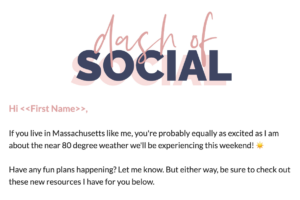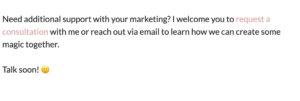
5 Components of a Great Newsletter
Are you ignoring your email list simply because you don’t know what to do with it? If so, you’re missing the opportunity to nurture warm leads through newsletters.
Why is that important?
According to HubSpot, 77% of marketers have seen an increase in email engagement over the last 12 months, and smartphone users prefer to receive brand communications via email.
If you’re ready to get started but need some inspiration, we’re going to break down our best-performing newsletter to date to give you content ideas and highlight the components of a newsletter that will increase engagement.
Choose an Enticing Subject Line and Preview Text
![]()
The subject line is arguably the most important part of your newsletter, as that’s the first thing that will encourage your subscribers to open the email and read it. Avoid using something that’s along the lines of clickbait, but be sure to include some type of teaser, question, or statement that will intrigue the recipient.
As you’ll see here, using the subject line, “I’m Launching Something New…” gave a bit of a tease to the subscribers and made them want to find out what this “new” offer is. This newsletter had an open rate of 46.2%, with the average open rate for the marketing industry being 17.38% according to Mailchimp, so this data proves that the subject line drew in the subscribers.
Don’t just pay attention to the subject line, though – the preview text is equally as important, as that’s the one line following the subject line that the newsletter recipients will see when the email pops in their inbox. This is another opportunity to tease your audience with some information.
Write an Introduction Paragraph

We’ve found that including an introductory paragraph to greet the subscriber and give them an overview of what the email contains is a great way to lead them into what you’re going to be sharing. Be sure to include merge tags, as shown in the greeting above, to make the email more personal and customized to the recipient.
If possible, ask a question at the end of your introduction to prompt some type of response from your subscribers. The goal is to get them to engage with you as much as possible!
Design an Easy-to-Digest Format

Although you want your email to have a beautiful design, you also want to make sure it’s easy to consume. Designing an email that isn’t super cohesive can make it difficult for the recipient to follow along, and it may even influence them to close out of the email entirely, which is the last thing you want.
Create an email layout that’s easy on the eyes, clear, and engaging so that your subscribers actually go through and read the whole thing. You may even want to test a few different formats to see which one performs the best. We used to write paragraph-based emails for our newsletters that didn’t perform so great, but once we switched to this “digest” feature with blocks of headers, paragraphs, and buttons, we found that the performance increased drastically.
Include Multiple Calls-to-Action (CTAs)

The purpose of your newsletter is to get your subscribers to take action on something, whether it be:
- Reading a blog post
- Signing up for a consultation call
- Filling out a form
Or something else. That means that it’s crucial to include multiple calls-to-action (CTAs) throughout the email instead of only including one and expecting the recipient to follow through on it. We include a minimum of three buttons in our newsletters as well as links to give the subscribers multiple opportunities to click through, making it difficult for them to miss it.
This specific newsletter had a 2.1% click-through rate, which shows that including more links encourages more clicks.
End with a Closing Paragraph

Just like an essay you might write in school, it’s important to wrap up your newsletter with a closing paragraph to summarize what you stated throughout the email and communicate next steps with your audience.
The closing paragraph should have some type of CTA as well to give one last touchpoint to your subscribers, and it should also have some type of question that will prompt a response, just like the introduction paragraph.
Remember that as with everything else in marketing, what works for someone else might not work for you. It’s crucial to go through various testing stages to find out what resonates with your subscribers the most and tweak your email marketing strategy from there!
